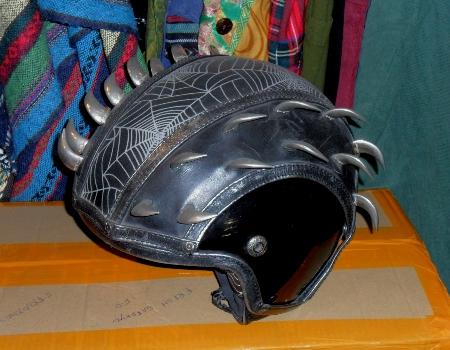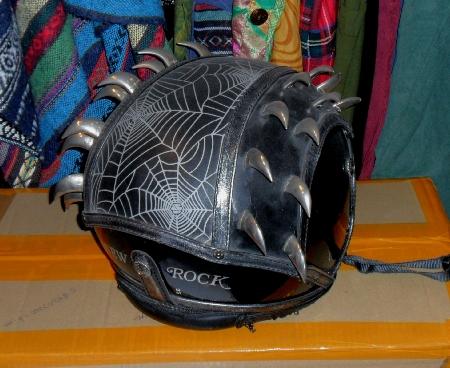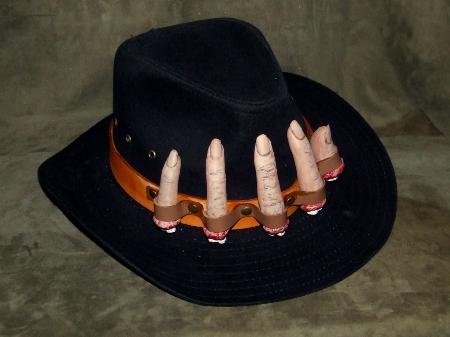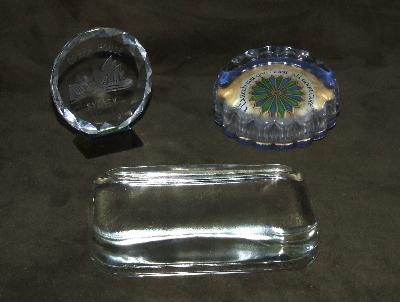-
Posts
5,931 -
Joined
Content Type
Profiles
Forums
Events
Blogs
Gallery
Everything posted by fredk
-
I have decided that very soon I shall buy a Tippmann Boss I'm going to get the package which includes a selection of needles, viz: Two 7x3 160, two 7x3 180, two 7x3 200, two 794200, two 794250 I would like to buy extra needles at the time I buy the package Now, being a total numpty those needle sizes mean nowt to me. Therefore I seek guidance Firstly, I do not make knife sheaths anymore. I'll be upping my production of shoulder bags, usually seams are no more than 4mm thick. Other items, maybe 5 to 6mm thick. I would like to try to make 'cowboy' or 'slim Jim' type holsters. I would also like to use the Boss just for making holes for hand-sewing. For this I prefer 0.5/0.6mm and 0.8/1.0mm thick thread What needles do youse suggest I should get extras of? And what size thread goes with some of those needles that Tippmann supply
-
These are all very loverly indeedy, and inspirational too How are you doing the lids? are you wet moulding over a buck then tooling it?
-
Thanks for responses chaps Out round Belfast yesterday. Very similar to Monday's outings. Just a few comments, from a child 'Thats a funny hat mummy' said to parent. From a lady 'Cool hat!' and the best to top it off was from an elderly man on the bus (yes, there seems to be men older than me!) (Note; that it was raining heavy at the time) 'Thats a handy hat to have today' Hardly anyone else noticed, but one young teenage girl did. She was with about 5 or 6 friends, she stopped in her tracks and stared wide-eyed at my hat and kept staring as I went on past her. Some of her friends bumped into her having not noticed she'd stopped walking A couple of ideas for some of youse to take up maybe 1. I spotted this motercikle crash helmet in an alternative clothing shop in Belfast. I asked and was given permission to take these photos. Cost of helmet is £350. I think the false leather is just glued to the helmet although there appear to be some basic type poppers along the front and rear edges. The spider's web design is just drawn on the 'leather' Those spikes can be bought for about 10 to 50p each (15c to 50c say) Something to do for / on bicycle helmets maybe? 2. I can't show a picture of this item because I cannot find one at all! I traipsed around Belfast and other places recently and my search returned a big fat 0, nil, nada, Round stiff hat boxes. To store your good going to church/going to a wedding hat in. All I could find are fold-up felt ones, which will keep the dust off but do not protect the hat from crushing It used to be, and I'm not talking of so very long ago, that when you bought an expensive hat you got a stiff round card box to keep it in. But I cannot find these available anywhere. Enquiries at hat shops; hats are given to the customer in a plastic or paper bag. It might be different in the USA / Canada / France A woman will spend £200 plus on a special hat for an occasion. I actually met a woman who spent £1500 on a hand-made hat for wearing at a Royal event. And what do they get to keep the hat in? a paper bag! This is something we as leather workers/crafters can make quite easily. Its just a dice cup with a lid but really, really big. And easier to make Two pieces of 3oz / 1.2mm veg or chrome tan, flesh side of each stuck to a piece of cardboard for the wall. Using Gezzer's method of dropping in a round base (very clever that), again a disc of relatively thinnish leather, two pieces laminated with thicker cardboard and repeat for the lid, slightly larger diameter and shallow. Add leather strap handles, job done. The fold up felt hat container sells for about £16. We could get much more for a nice quality leather one, and it could be tooled to make it even more unique The reason I got into this is I was looking for hat boxes to keep some of my hats safe. Its now a 'winter' project to make a few hat boxes Discuss in 10,000 words or less and have in to me for marking by end of Black Friday
-
On Sunday I finally got round to making my 'severed fingers' hat band On Monday, today, I wore it. I was quite surprised that only two people spoke to me about it and just a few children, maybe 3, stared wide eyed at it. It was like, seeing 'severed fingers' on a cowboy hat is just an everyday sight! I'll be wearing it out around Belfast tomorrow, Tuesday
-

Air pods case
fredk replied to Chux's topic in Purses, Wallets, Belts and Miscellaneous Pocket Items
It looks grand to me The thread is not necessarily too large, but I would use a smooth hammer/mallet to tap down the stitches -
After a certain amount of time the edit facility goes away. If you've sold something post a new message under that item to say it is sold then go to the top right corner of the message. You'll see a 'Report Post'. Click on that and in the reason for reporting put in that the item is sold and the sales posting can be archived. A moderator will see this and archive your for sale thread
-
My suggestion is my method for removing mild marks on leather which I have mistakenly or inadvertently made. Sometimes a bit of a ghost mark can still be seen, by me, but not others, and that is usually worked over anyways
-
I use my local version of 'Mop & Glo'. My version is water-thin but I think the US version is thicker and needs thinning with water. About 3 thinned coats will do. Any more than that and its starts to be too thick
-
How big? How deep? a few photos and more details would help If its not deep you could try soaking the leather and while it dries out burnish the top surface with something flat and hard. For this I use glass paperweights Like the one top right and the large one at the bottom of the photo
-
Scrap leather used with plastic cable ties are great for holding leather to round things
-
Over here we have painters tape called 'Frog tape'. There are three or four 'grades'. I use a standard one with my plastic modelling and I use the 'Green', the low tack grade on my leather. I use it to mask off the squares on my game boards and other similar jobs. This tape has never left any residue or reacted with dyes, paints or top finish. Actually, sometimes the low tack can be the problem!
-
I like to use these sewing hole pliers. The teeth are about 2mm wide with about 2.5mm between them. They can punch through thin leathers, up to about 4.5 mm thick. They are available with 4 teeth or 2 teeth I use 0.8 or 1mm thread with, afair a 17g needle
-
btw, the method I described was basically the way I used to re-cover sword and dagger grips in my medieval presentation group. The underlaying wood was often shaped
-
What about Sergey? He has an advert at the top of the LW pages Makes most excellent stamping tools
- 10 replies
-
Just a thought; I would drop to 1.2 - 1.6 mm (3 to 4 oz). lightly glue one edge of a piece to the stick. Bring it around and trim the other edge to meet to first. Lightly glue that edge down. Mark matching stitching holes. Remove the leather and use leather lace to stitch it. Put it back on the stick then wet mould it
-
It will stamp worse,. Even on a small project its best to case only once and keep it damp, even in just a sealable plastic bag Are you speaking of top surface burnishing or edge? The edges will burnish up real nice and easily, it will take a lot of effort, and I mean a lot, to burnish the top surface
-
Yes it does alter After your first casing when the leather dries you'll find it stiffens up and also shrinks a bit After each subsequent casing the leather will get ever so slightly more stiff but won't shrink by very much, if at all To counteract this stiffening you should feed it with nfo as it dries after casing Upon the initial casing it will tool nicely and easily. Upon subsequent casing it will need more effort to tool well. But we are talking of it'll just need a greater whack on the tool with the mallet, not having to use a 15lb sledgehammer. The difference is there but not too noticeable If you are going to tool over a period you can do a first casing, keep the leather damp with a sponge as you work. At the end of a session wrap it in ceran food wrap and put it in the fridge until the next session. It will keep for days like this. When I do this I put just a little bit of bleach in the casing water to prevent mould from growing
-
Chromexcel is a trade name for a leather that has been both chrome and veg tanned. Veg tanned to give the leather bulk and stiffness and chrome tan to make it supple
-
I would just use 1.5mm (approx) veg tan. I'd dye it a contrasting colour, such as a light tan or black, or even a colour such as blue, red or green
-
yeah. me too.
-
My family used to have a set that looked exactly like those The forks were 'pickle forks' , the straight un was for pickled onions and the nut crackers. On of my older sisters used to torture me by using the nut crackers on one of my fingers ; ~ 'do as I say or want or. . . . ' as she squeezed Back on topic; it does look like the pickle forks have been re-purposed to edge bevellers and/or for pulling out small tacks, like shoe sole tacks
-
Very nice wee purse. Excellent use of 'scrap'. But as we know, there is no 'scrap' in leather crafting. Every sq mm can be used in some way
-

Friction Swivel, Anyone know where I can get these?
fredk replied to pdbalestracci's topic in Hardware and Accessories
What size do you need? https://www.nautimarket-europe.com/en/Trem-Stainless-Steel-Friction-rotating-base-for-seats-175x175mm-TRD1712563







